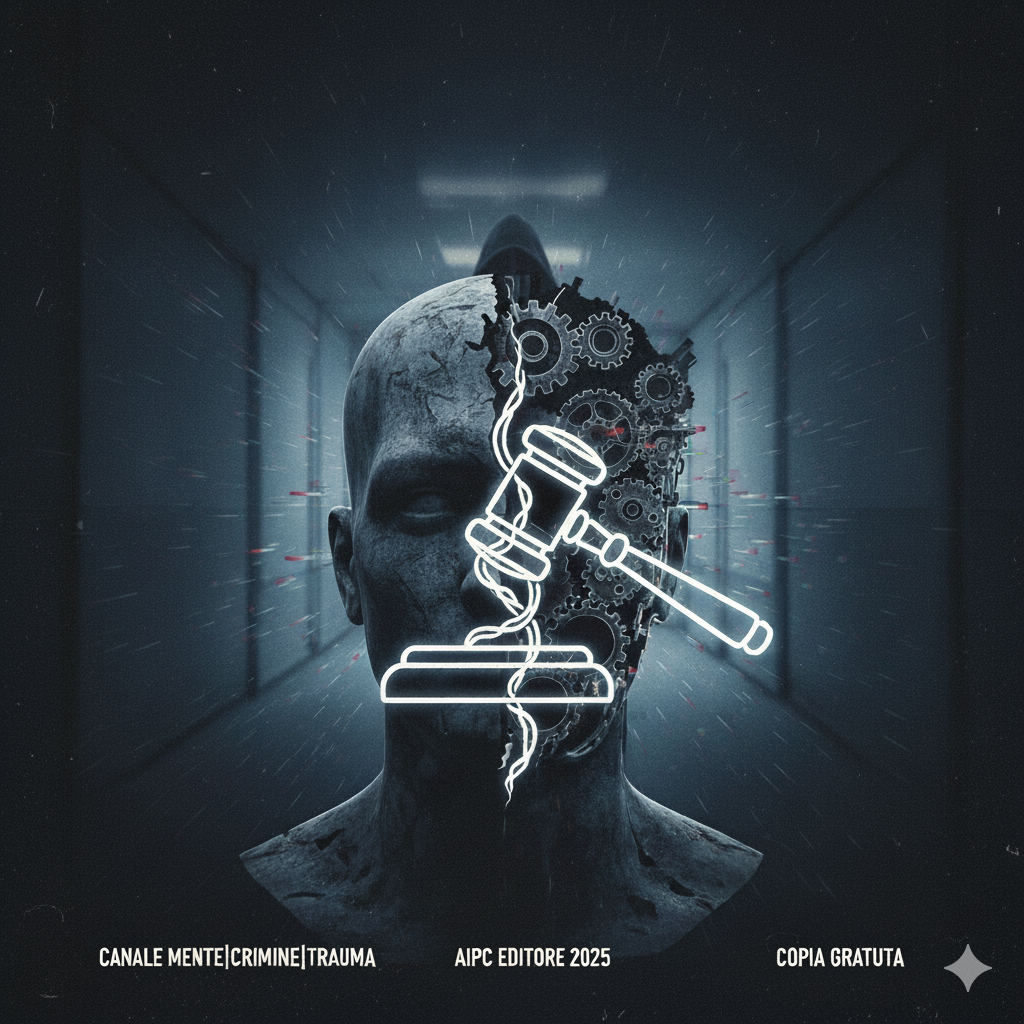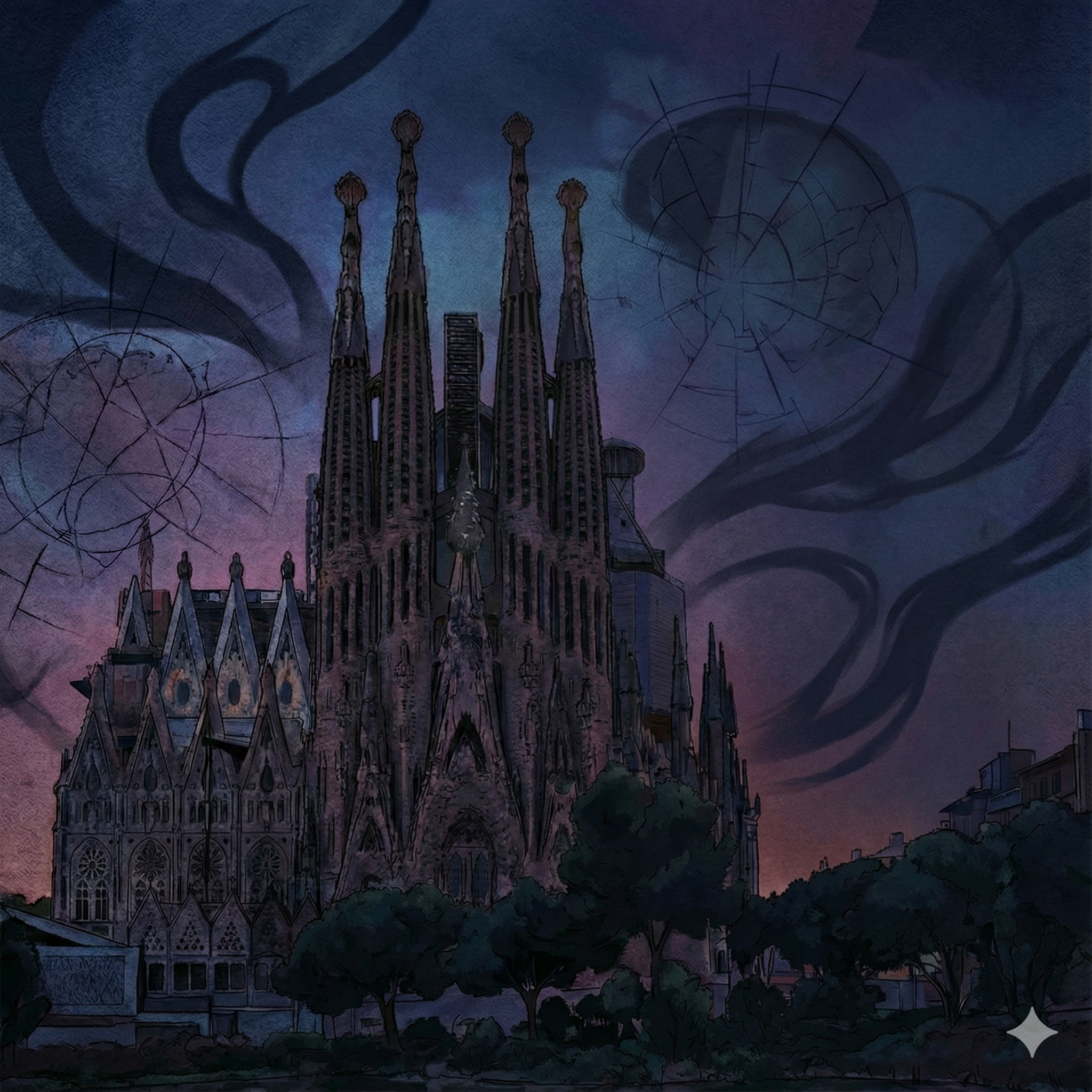The echo of invisible wounds: a judicial relational psychotraumatological analysis of the ELIA DEL GRANDE case
Abstract
This article analyzes the case of Elia Del Grande, the perpetrator of the triple homicide of his family members in Cadrezzate in 1998, through the theoretical lens of Judicial Relational Psychotraumatology. Adopting the methodological framework of the Italian Association of Psychology and Criminology (AIPC) and the Italian Center for Relational Psychotraumatology (CIPR), and drawing on the contributions of Lattanzi, Calzone, van der Hart, Nijenhuis, Steele, and Bowlby, the analysis departs from a purely criminological interpretation to examine the etiology of the violent behavior. It is postulated that Del Grande's entire life trajectory, from the parricide to subsequent offenses up to his recent escape, represents a coherent sequence of dissociative acting-out, rooted in unprocessed complex relational trauma originating from a disorganized attachment context. The article deconstructs key events—childhood, the crisis in Santo Domingo, the homicidal act, and the subsequent institutional career—as manifestations of the splitting of the personality into an Apparently Normal Part (ANP) and an Emotional Part (EP). It concludes that the judicial system's response, being uninformed by trauma, failed to address the underlying causes of the violence, perpetuating a cycle of dysregulation and re-traumatization. The article highlights the need for a judicial paradigm that integrates the principles of psychotraumatology for more effective prevention and rehabilitation.
Introduction: Beyond the Act, Toward the Origin
The case of Elia Del Grande, perpetrator of the "massacre of the bakers" ("strage dei fornai") in Cadrezzate on January 7, 1998 (Giovannelli, 2023), represents a paradigmatic example of how violent acting-out can be the final, catastrophic expression of a lifetime of unprocessed relational trauma. This article aims to move beyond sensationalist reporting to provide a structural and in-depth analysis of Del Grande's trajectory, from his developmental years to his recent escape from a work-release facility on October 30, 2025 (Image provided by user).
The methodological framework adopted for this analysis is based exclusively on the theoretical lens of Relational Psychotraumatology, as defined by the Italian Association of Psychology and Criminology (AIPC) and its Italian Center for Relational Psychotraumatology (CIPR) (AIPC, 2025a; AIPC, 2025b). Specifically, it applies the model of Judicial Relational Psychotraumatology, a discipline that applies the principles of psychotraumatology to the legal and forensic context. This approach deals with the assessment of post-traumatic symptoms in civil and criminal fields, analyzing how traumatic experiences, especially in childhood, influence emotional dysregulation and the narrative of events, with direct implications for assessing imputability, witness reliability, and the risk of recidivism (Studio RiPsi, 2026).
The analysis will draw substantially on the foundational contributions of Massimo Lattanzi and Tiziana Calzone (2025), interpreting Del Grande's actions not as isolated criminal choices, but as the predictable, albeit tragic, symptoms of a profoundly fractured Self, forged in a crucible of dysfunctional attachment (Bowlby, 1988).
The central thesis of this paper is that Elia Del Grande's entire life path—including the parricide, subsequent offenses, and final escape—constitutes a coherent narrative of unresolved complex trauma. Each event represents a reactivation of primary survival mechanisms (fight, flight, freeze) rooted in early relational wounds, which the judicial system has consistently misunderstood and failed to adequately address.
Section 1: The Architecture of Trauma: Developmental Hypotheses and Family Dynamics
1.1 The Caregiver Paradox in the Del Grande Family System
Although specific details about Del Grande's childhood are limited, the AIPC/CIPR model allows for the construction of a solid hypothesis based on observable outcomes. This theoretical framework posits that the most severe psychopathologies originate in an environment where the caregiver is simultaneously a source of need and a source of fear (Liotti, 2001). The Del Grande family, known publicly as successful "bakers," likely presented a façade of normality and industriousness that masked a chronic failure of emotional attunement (Lattanzi & Calzone, 2025). This generates a "paradoxical affective conflict," forcing the child into an unsolvable dilemma: to survive, they must seek proximity with the very source of their terror.
This dynamic leads to the development of a disorganized attachment style, characterized by contradictory behaviors and profound internal confusion, in which the other is experienced simultaneously as a refuge and a danger (Main & Solomon, 1990). Del Grande's known "psychological fragility" (Giovannelli, 2023) is the clinical term describing the outcome of such a developmental history. The family's public façade, focused on work and material success, suggests a system that prioritized productivity and appearance over emotional expression and validation. Such an environment is a known fertile ground for emotional neglect, a subtle but potent form of relational trauma, where a child's authentic needs are consistently ignored or invalidated (Lattanzi & Calzone, 2025). The vulnerabilities of a child like Elia become a threat to this image and are thus suppressed rather than understood, creating the exact conditions for chronic relational trauma.
1.2 The Formation of a Fractured Self: Structural Dissociation in Elia Del Grande
Faced with intolerable emotional states, the personality fragments as a survival mechanism. This phenomenon is explained by the Theory of Structural Dissociation (van der Hart, Nijenhuis, & Steele, 2011). It is possible to hypothesize that Del Grande developed:
- An Apparently Normal Part (ANP): This part is oriented toward daily functioning—working, socializing, attempting to conform. However, its primary function is the avoidance of traumatic memories and associated emotions. This part is "numbed" and strives to maintain a semblance of control (van der Hart et al., 2011).
- An Emotional Part (EP): This part is "frozen" at the time of the trauma and holds all the raw, unprocessed emotions (terror, rage, shame) and defensive survival responses (fight, flight, freeze) (van der Hart et al., 2011). The EP contains the "not-me" self-states, meaning sensations perceived as illegitimate, shameful, and unspeakable (AIPC, 2016).
His early behavioral problems, such as deserting military service after stealing a pistol (Giovannelli, 2023), can be interpreted as early "intrusions" of the EP's dysregulated state into the ANP's attempt to function. These are not mere offenses, but critical diagnostic markers of his internal state. Desertion is a "flight" response from a rigid, authoritarian system that likely mirrored his oppressive family dynamics. The theft of a weapon is a desperate attempt by the EP to gain a sense of power and agency in a world perceived as overwhelming and threatening.
1.3 Shame as the Silent Organizer
In cases of interpersonal trauma, shame—not fear—is the dominant and most corrosive emotion (Wilson, 2022). It functions as a primitive survival strategy, an "internalized brake" that teaches the child to suppress their needs and actions to avoid punishment or rejection from an unsafe caregiver (Schore, 2008, cited in Wilson, 2022). It can be inferred that Del Grande's identity was organized around a core of toxic shame. His subsequent aggression and "braggadocio" (Giovannelli, 2023) are classic defenses against this unbearable feeling of unworthiness. Rage serves to mask the underlying pain and generate a fleeting, illusory sense of power (Wilson, 2022). This shame is the "wordless secret" of the "not-me" part of the Self (AIPC, 2016).
Section 2: The Traumatic Catalyst: Santo Domingo and the Reactivation of Relational Conflict
2.1 The "Partner Paradox" and the Search for an Emotional Homeland
The family's decision to send Elia to Santo Domingo was a "strategic error" (Giovannelli, 2023) of catastrophic proportions. From a psychotraumatological perspective, it was an act of extrusion, a way to banish the "problem" rather than address it. This act of physical removal by the family system, likely motivated by the preservation of their public image rather than Elia's well-being, represented a profound act of neglect, almost an abandonment, which precipitated his psychological collapse.
In Santo Domingo, Del Grande's relationship with Raisa becomes the central drama. According to the "Partner Paradox" by Lattanzi and Calzone (2025), individuals with trauma histories are unconsciously drawn to partners who "speak the same traumatic language." Raisa, described as a young prostitute (Giovannelli, 2023), likely represented an "emotional homeland": a relational dynamic based on vulnerability, transaction, and instability that resonated with his inner world. The intensity of his attachment ("he completely loses his mind" [Giovannelli, 2023]) is characteristic of a trauma bond, not healthy attachment.
2.2 Affective Dysregulation and the Collapse of the ANP
Removed from the (albeit dysfunctional) containing structure of his family, Del Grande's ANP lost its external scaffolding. His subsequent "life of total dissolution," characterized by weapons and aggression (Giovannelli, 2023), is a textbook manifestation of severe affective dysregulation—the primary symptom of complex trauma (van der Hart et al., 2011). He oscillated between hyper-arousal (fight/flight: aggression, paranoia) and hypo-arousal (freeze: probable substance use, emotional numbing) without any capacity for self-regulation. This demonstrates the complete failure of the ANP to manage the overwhelming intrusions of the EP.
2.3 Family Rejection as Acute Re-traumatization
Upon his return, the family's refusal to discuss his relationship with Raisa (Giovannelli, 2023) was a reactivation of the primary trauma: the invalidation of his emotional reality. The final confrontation on the evening of January 6, 1998, was the definitive trigger. The "contempt" expressed by the family and, critically, the racist insult from his brother (Giovannelli, 2023), constituted an acute and overwhelming re-traumatization. This was not a simple argument, but an existential threat to his already fragmented Self, a final, violent confirmation of his unworthiness and "otherness" within his own family. The racist insult was not just an offense; it was the symbolic annihilation of his chosen attachment object (Raisa) and, by extension, Elia himself. For the EP, which holds the central trauma of being invalidated, this was the ultimate confirmation of its deepest fear: to be irredeemably "wrong" and deserving of destruction. This unleashed the "fight" response in its most extreme and lethal form.
Section 3: The Dissociative Act: Deconstructing the Homicide
3.1 Violence as the Language of the Emotional Part (EP)
The triple homicide on January 7, 1998, must be understood as a catastrophic "acting-out" that occurred in a dissociative state. The re-traumatizing confrontation with the family caused the complete collapse of the ANP and a total takeover by the EP (van der Hart et al., 2011). The "fury" described in reports (Giovannelli, 2023) is the raw, undifferentiated rage of the EP, suppressed for years. The violence was not directed in a calculated way against three distinct individuals, but against the "family unit" as the single source of his lifelong trauma. This aligns with the AIPC/CIPR understanding of violence as a "narrative of the trauma" (AIPC, 2025c), a desperate, non-verbal communication of unbearable pain. The very nature of the act, a "massacre" implying extreme and personal violence, points directly to the "fight" response of the EP, an expression of the embodied rage that characterizes this dissociated part.
3.2 The Absence of Psychiatric Evaluations and the Hypothesis of Dissociative Amnesia
Although specific court-ordered psychiatric evaluations are not available in the research records, the AIPC/CIPR framework provides a powerful explanatory model. The nature of the crime strongly suggests a state of dissociation, potentially accompanied by amnesia for the event itself, a well-documented phenomenon in crimes of extreme passion or trauma (UNID, 2024). In such a state, consciousness is severely altered, and actions become automatic, driven by primitive survival circuits (UNID, 2024). The individual is not in control of their cognitive functions. A formal evaluation conducted through this lens would likely have identified Complex Post-Traumatic Stress Disorder (C-PTSD) with severe dissociative features, rather than a simple personality disorder or calculated malice.
3.3 The Immediate Confession as the Return of the ANP
Del Grande's rapid and uncoerced confession to Swiss authorities upon his arrest (Giovannelli, 2023) is highly significant. It can be interpreted as the re-emergence of the "Apparently Normal Part" (ANP). The EP, having discharged its overwhelming emotional load, retreated, leaving the ANP to confront the terrifying consequences. The ANP does not "own" the EP's actions; it experiences them as alien and horrifying. The confession is therefore an attempt by the ANP to make sense of the incomprehensible and to restore some semblance of order to a shattered reality. The sequence of events follows a classic trauma response pattern: first the "fight" response (the homicides), immediately followed by the "flight" response (the attempt to reach Switzerland). His capture interrupted this sequence, leading to the re-emergence of the ANP and the subsequent confession.
Section 4: The Institutional Echo: Justice, Detention, and Unresolved Trauma
The entire history of the case, when analyzed through the psychotraumatological lens of AIPC/CIPR, reveals a continuous and coherent interaction between external events and internal psychological dynamics. Before 1998, Del Grande's known "psychological fragility" and his military desertion (Giovannelli, 2023) can be interpreted as manifestations of Complex PTSD stemming from a hypothetical chronic relational trauma; these were the first intrusions of the Emotional Part (EP) and its survival responses, particularly "flight."
In 1997, the family's decision to send him to Santo Domingo, where he led a "dissolute life" (Giovannelli, 2023), acted as an extrusion from the family system. This led to the collapse of his Apparently Normal Part (ANP) due to severe affective dysregulation in an unstructured environment. The confrontation with the family on January 6, 1998, culminating in a racist insult (Giovannelli, 2023), constituted an acute re-traumatization, a symbolic annihilation of the Self that triggered the catastrophic collapse of the ANP and the total takeover by the EP.
The triple homicide on January 7, 1998 (Sky TG24, 2025), was the "fight" acting-out of the EP, a dissociative discharge of accumulated traumatic rage. His immediate flight to Switzerland and subsequent confession (Giovannelli, 2023) represent the EP's "flight" response, followed by the re-emergence of the horrified ANP, which confessed to restore order.
The trial, beginning in October 1998 with a 30-year sentence (Giovannelli, 2023), shows how the legal system interpreted the dissociative act as premeditated murder, focusing on the behavior ("the what") rather than the etiology ("the why"). The 25 years in prison served until 2023 (Image provided by user) passed without trauma-specific therapy, leaving the underlying traumatic structures (ANP/EP split, dysregulation) untreated and likely reinforced.
After his release, the thefts and harassment of neighbors (Image provided by user) were a predictable consequence of dysregulation, with the ANP unable to cope with life and acting-out as a symptom of the still-active trauma. Consequently, before October 2025, he was declared "socially dangerous" and sent to a work-release facility (Image provided by user), a trauma-uninformed response that re-labeled the symptom ("dangerousness") and prescribed further confinement, itself a trigger. Finally, his escape on October 30, 2025 (Image provided by user), is a classic "flight" trauma response, triggered by the perceived threat of the facility's control and confinement.
4.1 The Judicial Process and the "Socially Dangerous" Label
The 30-year sentence and subsequent legal management of Del Grande exemplify a fundamentally trauma-uninformed system. The post-release offenses of theft and harassment are not proof of an incorrigible "criminal mind," but the predictable symptoms of an individual lacking the skills for emotional regulation or healthy relational functioning (AIPC, 2025b; R57). The declaration of "social dangerousness" is a critical diagnostic error. The system correctly identifies the risk but misattributes its cause. It sees danger, where a psychotraumatologist would see profound dysregulation. The prescribed solution—a "work-release facility"—is therefore counter-therapeutic, as it re-imposes a controlling, restrictive environment that is itself a potent traumatic trigger.
4.2 The Escape as a Predictable Trauma Response
Del Grande's escape on October 30, 2025, should not be seen as a cunning criminal plan. It is the logical and predictable outcome of placing an individual with untreated complex trauma back into a situation that mimics the helplessness and lack of agency of his original trauma. The act of "climbing the wall" is a literal and desperate enactment of the "flight" survival response, triggered by the perceived threat of the institution. His nervous system, still stuck in 1998, did what it is programmed to do when it feels threatened: flee. The entire post-homicide path shows how the legal and carceral system can become an agent of re-traumatization. By focusing exclusively on punishment and containment, it ignores the root cause of the violence. Every step—the long detention without adequate therapy, the "dangerous" label, the new confinement—serves to reinforce the EP's worldview that the world is a threatening place and authority figures are dangerous.
Conclusion: From Punishment to Reparation
The life of Elia Del Grande is a devastating case study of the core principles of AIPC/CIPR. It illustrates how chronic, unaddressed relational trauma can lead to a fragmented Self, organized around shame and managed through dissociation. It shows how subsequent life events can act as powerful triggers, leading to catastrophic violence, and how a trauma-uninformed societal response can perpetuate a cycle of dysregulation and acting-out.
The tragedy of this case lies in its predictability, and therefore, its potential preventability. An intervention guided by the AIPC/CIPR model would have followed a phased approach (van der Hart et al., 2011):
- Stabilization and Safety: The first priority would not have been punishment, but the creation of a safe therapeutic relationship and the teaching of emotional and physiological regulation skills, potentially using biofeedback and neurofeedback (AIPC, 2025d).
- Processing of Traumatic Memories: Only once stability was achieved would therapeutic work have begun on the careful processing and integration of the traumatic memories held by the EP, allowing the ANP to understand and "own" the entire life story.
- Integration and Reconnection: The final phase would have focused on grieving the past, developing healthy relational skills, and building a new life narrative no longer defined by trauma.
The Elia Del Grande case is a stark warning that "prison is not enough" (ONS, 2022). For crimes rooted in profound trauma, justice cannot be achieved through punishment alone. True prevention and rehabilitation require a scientific, compassionate, and trauma-informed approach that seeks to heal the wounds that fuel the violence.
References
AIPC. (2016). La relazione terapeutica e il cambiamento [The therapeutic relationship and change]. Associazione Italiana di Psicologia e Criminologia.
AIPC. (2025a). Psicotraumatologia relazionale: una definizione integrata [Relational psychotraumatology: an integrated definition]. Associazione Italiana di Psicologia e Criminologia.
AIPC. (2025b). Rubrica: Lo psicotraumatologo relazionale del CIPR risponde [Column: The CIPR relational psychotraumatologist answers]. Associazione Italiana di Psicologia e Criminologia.
AIPC. (2025c). Due tombe: Quando il dolore sepolto uccide ancora [Two graves: When buried pain still kills]. Associazione Italiana di Psicologia e Criminologia.
AIPC. (2025d). Prevenire la Violenza con la Scienza: Psicotraumatologia per ridurre le recidive [Preventing Violence with Science: Psychotraumatology to reduce recidivism]. Associazione Italiana di Psicologia e Criminologia.
Bowlby, J. (1988). A Secure Base: Parent-Child Attachment and Healthy Human Development. Basic Books. (Ital. trans. Una base sicura. Applicazioni cliniche della teoria dell'attaccamento. Raffaello Cortina Editore, 1989).
Giovannelli, M. (2023). Ep.2 - La mail che fece luce sul delitto di Cadrezzate [Ep.2 - The email that shed light on the Cadrezzate crime]. Varese News Rewind [Video]. YouTube.
Lattanzi, M., & Calzone, T. (2025). La bolla traumatica e il paradosso del partner [The trauma bubble and the partner paradox]. Associazione Italiana di Psicologia e Criminologia.
Liotti, G. (2001). Le opere della coscienza. Psicopatologia e psicoterapia nella prospettiva cognitivo-evoluzionista [The works of consciousness. Psychopathology and psychotherapy in the cognitive-evolutionary perspective]. Raffaello Cortina Editore.
Main, M., & Solomon, J. (1990). Procedures for identifying infants as disorganized/disoriented during the Ainsworth Strange Situation. In M. T. Greenberg, D. Cicchetti, & E. M. Cummings (Eds.), Attachment in the preschool years: Theory, research, and intervention (pp. 121–160). University of Chicago Press.
ONS. (2022). Osservatorio Nazionale sullo Stalking: "Il carcere non basta" [National Observatory on Stalking: "Prison is not enough"]. StopStalkingItalia.it.
Sky TG24. (2025, November 1). Sterminò la famiglia nel 1998, Elia Del Grande fugge da comunità [He exterminated his family in 1998, Elia Del Grande escapes from community].
Studio RiPsi. (2026). Psico-traumatologia clinica: Valutazione giuridica e forense delle sindromi post traumatiche [Clinical psycho-traumatology: Legal and forensic assessment of post-traumatic syndromes].
UNID. (2024). Delitto di Cogne: Analisi Criminologica [The Cogne crime: Criminological Analysis]. Unidprofessional.com.
van der Hart, O., Nijenhuis, E. R. S., & Steele, K. (2011). Fantasmi nel sé. Trauma e trattamento della dissociazione strutturale [The Haunted Self: Structural Dissociation and the Treatment of Chronic Traumatization]. Raffaello Cortina Editore.
Wilson, I. (2022). Il trauma relazionale: qual è il ruolo della vergogna? [Relational trauma: what is the role of shame?]. IPSICO.it.



